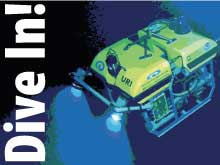
These lesson plans focus on the Deep Scope 2004 exploration.
Education Lesson Plans
The Operation Deep Scope 2004 expedition presents a special opportunity to engage explorers of all ages as we journey to a world that few have seen. The mission of this expedition was set forth by the 2000 President’s Panel on Ocean Exploration: to go beyond traditional sampling limitations to “see the ocean through a new set of technological ‘eyes.’” Scientists will use advanced technologies, such as the sophisticated Eye-in-the-Sea underwater camera system, to see animals and behaviors never before witnessed by humans. The Harbor Branch Oceanographic Institution’s research vessel Seward Johnson and its manned submersible, the Johnson-Sea-Link, will take scientists to an area in the northern Gulf of Mexico, described as one of the most geologically complex regions on the planet, with basins, canyons, escarpments, and methane seeps.
Educators and scientists working with NOAA during July 2004 developed a series of lesson plans for students in Grades 5-12 that are specifically tied to the Deep Scope 2004 expedition. These lesson plans focus on cutting-edge ocean exploration and research with state-of-the-art technologies. Lessons focus on the basic chemistry of bioluminescence, bioluminescent adaptations in deep-sea organisms, and how bioluminescence can be used to study life in deep ocean environments. Additionally, chemiluminescence, bioluminescence, fluorescence, and phosphorescence are compared and contrasted.
The lesson plans are grouped into the following categories:
Grades 5-6
Grades 7-8
Grades 9-12
Each grade-level grouping includes an activity that focuses on the exploration and research being conducted as part of the Deep Scope 2004 expedition. In addition to being tied to the National Science Education Standards, the hands-on, inquiry-based activities include focus questions, background information for teachers, links to interesting Internet sites, and extensions. Web logs (complete with compelling images and video) that document the latest discoveries and complement the lesson plans will be sent back each day from sea. Teachers are encouraged to use the Deep Scope 2004
daily logs, which are posted on this site, to supplement the lesson plans.
Read a description of each lesson plan and/or download them to your computer. All of the lesson plans are available in pdf format, and may be viewed and printed with the free Adobe Acrobat Reader ![]() . To download a lesson plan, click on its title from the listing below.
. To download a lesson plan, click on its title from the listing below.
Grades 5-6
Cool Lights (PDF, 220Kb)
Focus: Light-producing processes and organisms in deep-sea environments
In this activity, students compare and contrast chemiluminescence, bioluminescence, fluorescence, and phosphorescence. Given observations on materials that emit light under certain conditions, students infer whether the light-producing process is chemiluminescence, fluorescence, or phosphorescence. Students explain three ways in which the ability to produce light may be useful to deep-sea organisms and explain how scientists may be able to use light-producing processes in deep-sea organisms to obtain new observations of these organisms.
Grades 7-8
Who Has the Light? (PDF, 200Kb)
Focus: Bioluminescence in deep-sea organisms
In this activity, students compare and contrast chemiluminescence, bioluminescence, fluorescence, and phosphorescence. Students also explain at least three ways in which the ability to produce light may be useful to deep-sea organisms and explain how scientists may be able to use light-producing processes in deep-sea organisms to obtain new observations of these organisms.
Grades 9-12
Where Is That Light Coming From? (PDF, 208Kb)
Focus: Bioluminescence
In this activity, students explain the role of luciferins, luciferases, and co-factors in bioluminescence and the general sequence of the light-emitting process. Additionally, students discuss the major types of luciferins found in marine organisms, define the “lux operon” and discuss at least three ways that bioluminescence may benefit deep-sea organisms. Students give an example of at least one organism that actually receives each of the benefits discussed.
For More Information
Contact Paula Keener-Chavis, national education coordinator for the NOAA Office of Ocean Exploration, for more information.
Other lesson plans developed for this Web site are available in the Education Section.























